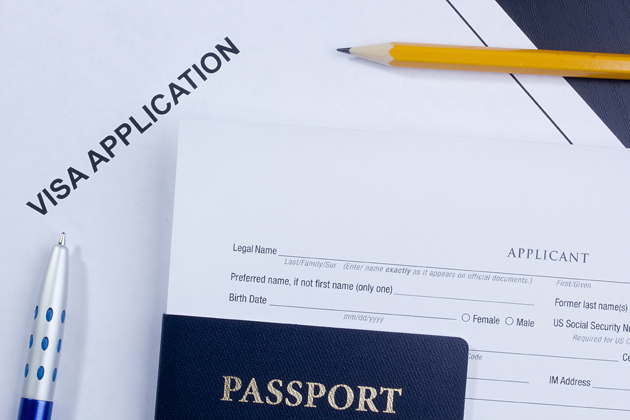
A Visa application form
apply for a Visa well in advance. Depending on the type of Visa, urgency of visit and the place of application, the appointment waiting time varies from 2 to 15 working days. Details are available on the U.S Department of State-Bureau of Consular Affairs website.
Non-immigrant vs. Immigrant
For all temporary purposes, you have to apply for a non-immigrant Visa, commonly known as B Visa. The maximum stay duration for B Visa is 6 months while its validity ranges from one to ten years, depending on your country of origin. If you are applying for a permanent residency, you have to apply for an immigrant Visa.
For Non-Immigrant Visas
For all temporary purposes, you have to apply for a non-immigrant Visa, commonly known as B Visa. The maximum stay duration for B Visa is 6 months while its validity ranges from one to ten years, depending on your country of origin. If you are applying for a permanent residency, you have to apply for an immigrant Visa.
Step 1. Determine your Visa type from the categories enlisted by the U.S Embassy
Step 2. Fill the Non-immigrant Visa Electronic Application DS-160
Step 3. Pay the corresponding Fee for your Visa type
Step 4.Schedule you appointment at the Visa Application Centre and the U.S Embassy or Consulate
Step 5. Appear for the interview and carry the required documents like:
- Valid passport
- DS-160 confirmation page
- Appointment confirmation page
- Document supporting your Visa type
Most Common Categories of Non-Immigrant U.S. Visa types:
- Business (B-1) or Tourism & Visit Visa (B-2) or combination of both purposes (B-1/B-2)
- Work Visa - H-1B, H-2A, H-3, H-4, L-1, L-2, O, P, Q
- Student Visa - F-1/M-1
For Immigrant Visas
Step 1. Get approval for a petition for immigration from the USCIS (U.S Citizenship and Immigration Services). The petition can be made by a qualified relative or a potential employer at a USCIS office in the U.S. If you are making a petition from India, you have to mail a duly filled form I-130 to the USCIS Chicago lockbox.
Step 2. Undergo a medical examination as per instructions from the embassy or the National Visa Centre (NVC).
Step 3. Once you have received an Immigrant Visa, pay the additional associated Immigrant Fee, before travelling to the United States.
Most Common Categories of Immigrant Visa types:
Immediate Relative & Family Sponsored
- Spouse of a U.S. Citizen - IR1, CR1
- Spouse of a U.S. Citizen awaiting approval of an I-130 immigrant petition - K-3
- Fiance(e) to marry U.S. Citizen and live in US - K-1
According to statistics of U.S Consulates around the world, the USA Visa Rejection Rate is higher in countries like India
General rules for all types of Visas
A few general rules apply across Visa types. You are better off knowing about them before you make an application for your visit Visa.
- Make sure you possess a passport valid for at least six months beyond the intended period of stay.
- You must have a clear, definite and non-ambiguous answer to your reason for stay, fixed intended duration of stay, evidence of funds to cover all expenses during stay and proof of residence outside the US along with enough reason for returning to home country/ wherever you are flying from, after the said duration is over. (Most Visa rejection cases happen due to failure of meeting this requirement.)
- Production of any false documents or misrepresentation of any kind can lead permanent Visa ineligibility.
- While filling Non-immigrant Visa Electronic Application DS-160, be especially careful as you cannot make changes after submission.
While Visa processing takes three working days, on an average, we recommend you apply at least three months prior to your planned travel date.